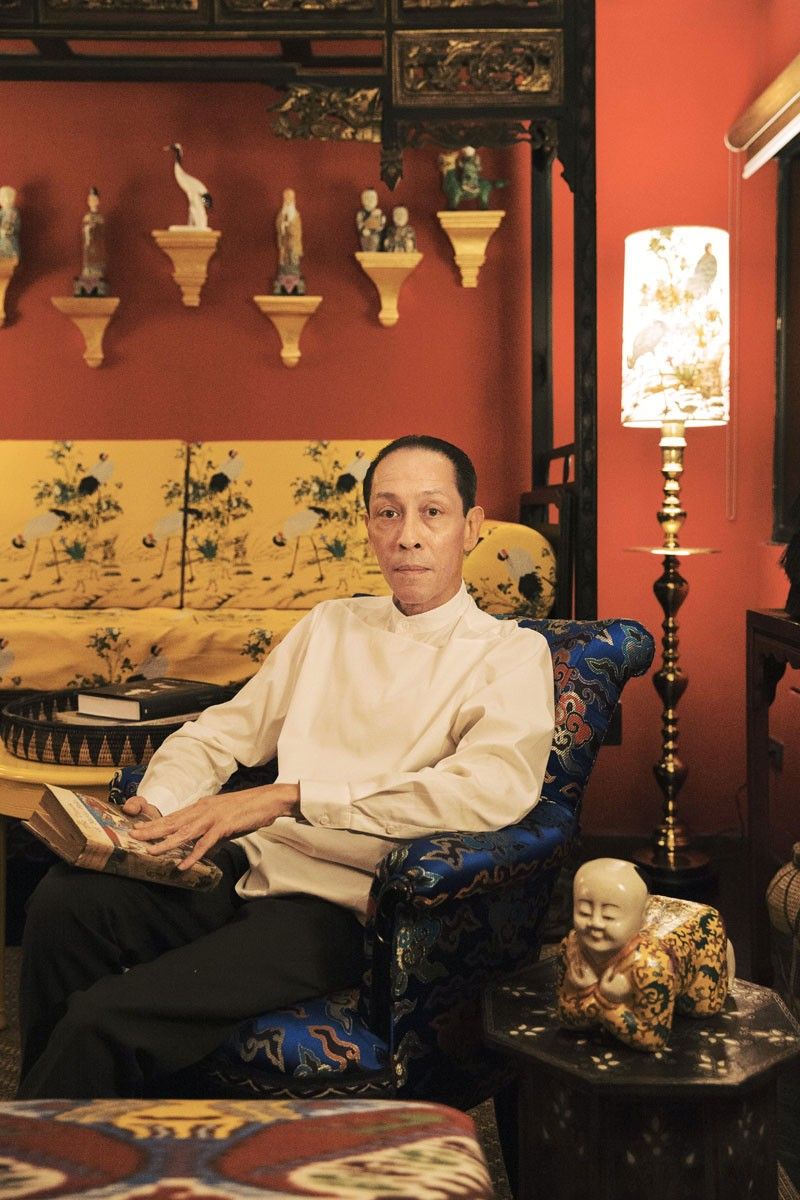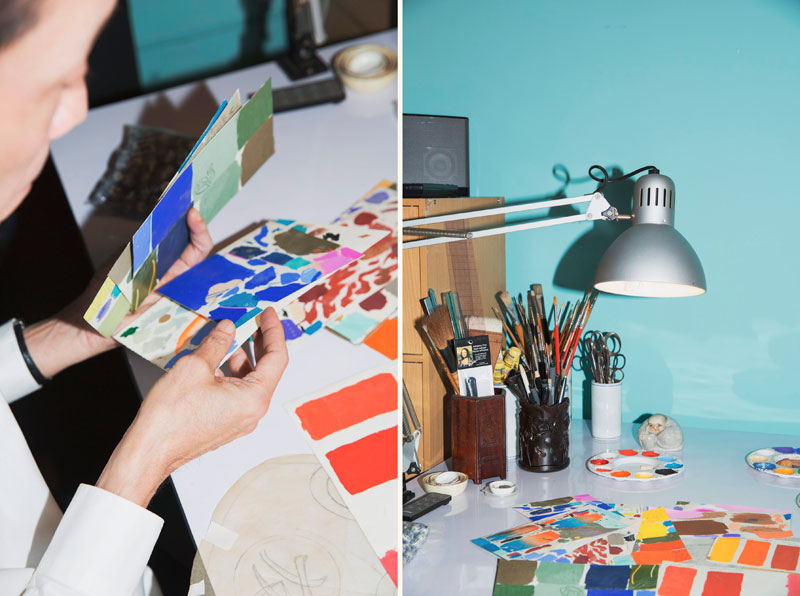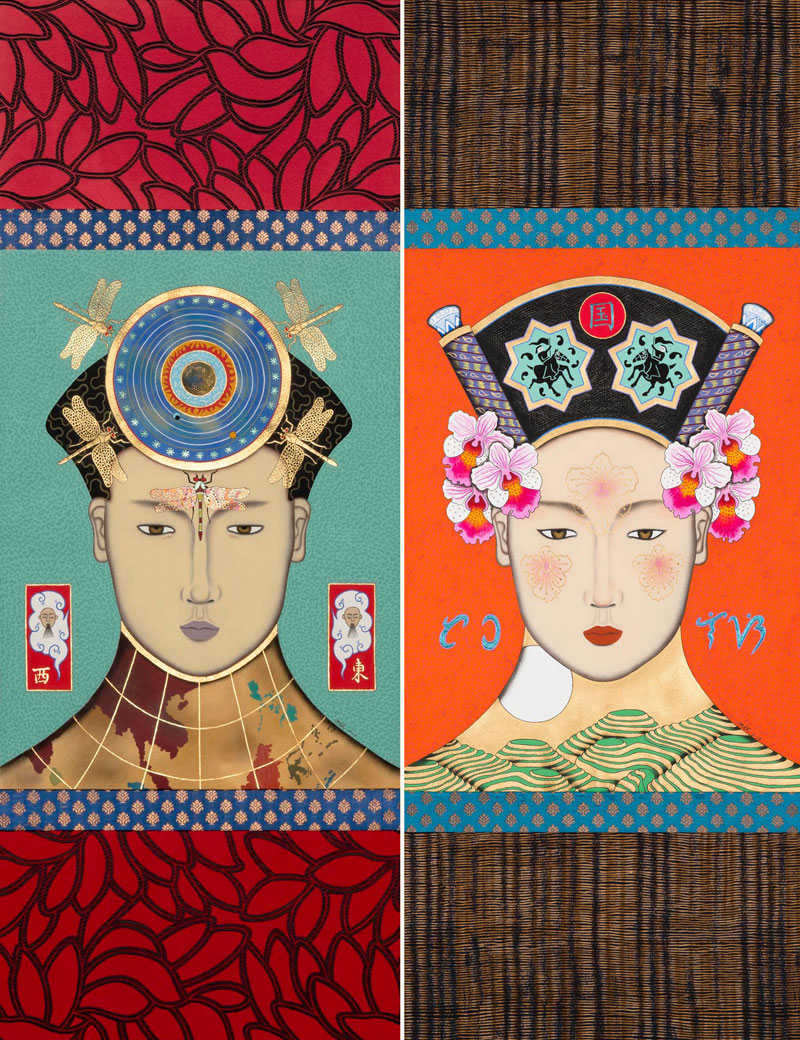It’s Mark Higgins’ world, we’re just living in it

With a little help from his friends, the multidisciplinary creative indulges in a bit of world-making at the Ayala Museum. “This is something we will be doing for the first time,” says Ayala Museum senior curator Ken Esguerra.
It’s not even sundown but Mark Lewis Lim Higgins is already passing around an opium pipe.
Forgive that provocation.
The artist, author, designer and fashion educator has long been known for his unique aesthetics and keen interest in orientalia but it’s an absurd sight, watching a respected figure in Philippine cultural circles — one of Philippine fashion history’s most dynamic gatekeepers — brandishing an opium pipe.
“A lot of the things you see around are, you know, junk,” he says, motioning to the antiques and artifacts — a mix of inherited treasures, lucky junkshop finds, and objects given new meaning through canny repurposing — scattered around his apartment.
“If you go to his apartment diba the color of the walls is lime, there are all sorts of beautiful things from Asia and also tacky things from Asia,” says the production designer Gino Gonzales, a close friend and frequent collaborator.
When Gonzales saw the paintings Higgins had been working on for the last three years in his apartment, he didn’t know what to think. Higgins had asked for his advice on the staging of his first exhibit in 12 years and the acclaimed production designer was having trouble finding a common thread.
“They were all gorgeous, of course,” Gonzales says. “Sabi ko, ‘Oh my gosh, how do I put this together?’ He had a lot of things in mind like putting spices, things from the east, exotica. Sabi ko, ‘Para tong bodega.’ And I thought, that might be a good image for what Mark is doing. You have this sort of repository of beautiful things from Asia that are stored in a bodega.”
If the body of work Higgins had produced had initially seemed sprawling to Gonzales, it might be because the objects that inspired the work are not just far-reaching but literally of different worlds and centuries. Years ago, at the beginning of a three-year process, Higgins had been frequenting the Ayala Museum, visiting the precious artifacts of the museum’s permanent collection. Those objects have inspired these new paintings.
Twelve years ago, Mark Lewis Lim Higgins staged his first solo show in the Philippines at the Ayala Museum. Over a decade later, he found himself back in the museum, inspired by the formidable permanent collection, and later, proposing a new show to Mariles Gustilo, the museum director.
“It was the director’s idea” to work with pieces from the permanent collection, Higgins says. “You know, a lot of the collection they have, I reference in my work. And she said, ‘Well, maybe we can bring down some objects to show with your paintings.’ I thought she was joking and, apparently, she wasn’t.
“So I sat with the curators and I said, ‘You know the first thing I’m going to ask for, right?’ It’s this gold halter, this ceremonial Buddhist halter that’s 3,800 grams of solid gold. It’s, to me, for many reasons, one of the most precious artifacts in this country. And they agreed.”

Scenes from the artist’s studio: “Art is something I’ve always done,” Mark Lewis Lim Higgins says. “About a decade ago, I took a hiatus from painting... By the time I realized (how much time had gone), it had been too long. I really wanted to get back to what I really do. This is three years of work.”
The resulting show, entitled “Gold in Our Veins,” in which Higgins’ paintings are presented in dialogue with a curated selection from the museum’s gold collection, Southeast Asian trade ware ceramics, as well as textiles personally loaned by Mercedes Zobel, will be exhibited at the Ayala Museum from Feb. 21 to May 26.
According to Ayala Museum senior curator Ken Esguerra: “The show is that notion of a lot of these explorers sailing towards this part of the world because of the wealth that the Philippines in particular has — gold, natural products we have, timber, all that stuff. He incorporated this into his art… He incorporated iconic objects derived from the museum collection and made art out of it, his portraits.
“We do loan out our objects for straightforward exhibitions but this is the first time we’re combining them with contemporary art,” Esguerra says. “The whole exhibit is an assemblage in itself. It’s really very exciting even for us here in the museum. This is something we will be doing for the first time.” In this way, Higgins functions as both artist and curator.
For his part, Gonzales has been tapped to set the scene. “Gino is a good friend and anytime any of us are working on a project, we always say, well, let me know if there’s any help you need,” Higgins says. “So I said, ‘Actually, I need help with the design because I don’t know anything about that.’ But Gino, being like myself, very O.C., he’s totally hands on now and created this spectacular idea,” adding that, “I’m recreating a bodega in Southeast Asia of a Chinese merchant probably around the ‘20s and ‘30s.”
The past decade has been a particularly prolific time for Higgins. In 2009, he took over the Slim’s Fashion and Arts School, the vocational training institution his mother, the legendary designer Salvacion Lim Higgins, founded half a century ago, with his sister Sandy. That same year saw the release of a coffee-table book chronicling the work of their mother (Slim: Salvation Lim Higgins) and the opening of an accompanying retrospective at the National Museum.
The next few years saw Higgins casting an even wider net and exploring latent interests with rigor and gumption. He worked on another coffee-table book, a tribute to the terno (2015’s Fashionable Filipinas: An Evolution of the Philippine National Dress in Photographs, 1860-1960), with the acclaimed production designer Gino Gonzales. A year later, he tried his hand at costume design, producing costumes for Ballet Philippines’ The Firebird that set the classic ballet in pre-Hispanic Philippines. For the production, Higgins made costumes that felt like a meeting point between Boxer Codex-era Philippines and the Ballets Russes.
Through all of that, it was easy to forget Higgins’ primary job. “(Art) is something I’ve always done,” he says. “About a decade ago, I took a hiatus from painting because we worked on the book of my mom, and shortly after that, I worked on the terno book with Gino, and my sister and I took over the school so we were running that.
“By the time I realized (how much time had gone), it had been too long. I really wanted to get back to what I really do. So in 2015, I started (working on these paintings). This is three years of work.”
Interestingly, how he got into Firebird was through the first few paintings he completed in 2015. It had been a while since he really focused on his art and he surprised himself with the subject matter that very naturally sprang from his art — the ancient history of Southeast Asia, which had long been an interest of the history buff inside Higgins but had suddenly come through very clearly and in a manner that was focused and purposeful. He was surprised when Ballet Philippines director Paul Morales contacted him with the idea of reimagining The Firebird in the exact same era Higgins had focused on for his paintings.
“It was a time in my life where I decided, mix all the fashion, all the art, all the costumes,” he says. “To me, they were always very separate worlds. I made it a point (to not mix them together)… I thought — maybe because I’m older, maybe because I don’t care — just mix it all up.”
Decorative defiance
The ironic thing about Higgins focusing on the worlds of fashion, design, and even the performing arts over the last decade is art has looked like an afterthought of his practice, despite the fact that he considers himself an artist first and looks at most of his projects from the point of view of a painter, or at least an aesthete. The unfortunate fallout is his art is sometimes not taken as seriously, or dismissed as decorative.
“One of my close friends warned me. She said, ‘You have to stop thinking that everyone around you thinks the way you do and understands the dots that you connect,’” he says.
Sometimes, you can understand why some people would think that. He refers to exhibits as “collections,” as though he’s working on a fashion collection, instead of an art exhibition. He doesn’t participate in the gallery system or the art fairs, choosing instead to exhibit with institutions like Ayala Museum and manage his own sales himself. And in fashion, he’s the same, with most of his friends coming from the performing arts scene rather than the world in which he was born into.
By moving within many worlds, he is in effect the son of no one. He occupies a niche all by himself, a transient figure in different worlds, a luminary of no world’s but with the fire and freedom to follow his own muse.
“Someone asked me once, ‘Are you not worried that your art will be written off as decorative?’ I said, well, if you think about it, think of what a normal person knows as to be some of the most famous paintings in the world — Gustav Klimt’s ‘The Kiss,’ Claude Monet’s ‘Water Lilies.’ So if you want to put me in with those people, I’m quite honored.
“For this collection, I wasn’t trying to think of some profound message to tell the world. I was just trying to have fun,” he adds. “There are a lot of humorous little elements in it. It’s a ‘Let’s just have a good time’ kind of thing. I’m not one of those artists who believes you have to suffer for your art, like Gabby Barredo — hey, he’s a good friend.

“Varuna” and “Wahi Arduja” by Mark Higgins
“One of my artist friends said in an interview, ‘Isn’t all art meant to be provocative and disturbing?’ I don’t agree. I think it works for some people. But I think a shark in a fish tank or a diamond-studded skull will only take you so far. Creating something beautiful has a more universal appeal. Literally everyone from all walks of life here can look at the work and react to it because it’s positive.
“I mean, if you took Botticelli’s ‘Birth of Venus’ to the middle of tribal Africa, or somewhere in Iceland, they would probably think it’s quite beautiful. If you took the ‘Floor Cake’ of Claes Oldenberg, they would wonder what that was, right?”
It seems almost right, then, that while most of the Philippine contemporary art scene will be at The Link on Wednesday, Feb. 20, amidst the frenetic buzz of Art Fair Philippines 2019, Higgins will be across the street, in his own bodega in Ayala Museum, opening his first exhibit in 12 years.
“I think it’s a continuation of what he does,” Gonzales says of “Gold in Our Veins.” “It’s unapologetic. There are some people who dismiss it as decorative work. But I think it’s a fusion of things that go on in his mind — his fascination for literature, different countries — and what he sees as valuable.”
The book about the terno, the documentation of his mother’s couture, the passing-on of techniques and traditions at the school, the ballet about pre-Hispanic Philippines — Higgins seems to defiantly stand against the times, forcing us to look at the aspects of our past that foreshadow our present and maybe provide clues to our future. It’s not a point of view that feigns ignorance on social realities or attempts historical revisionism but a willful determination to look at a side of our history, an aspect of our culture, that runs the risk of being forgotten but could actually possess the secrets to our people’s grace and beauty.
“Because I’ve been spending time in the Philippines, it’s trying to tell the story of the country or aspects of it that people aren’t so familiar with,” Higgins says. “Especially when our daily lives are so immersed in poverty, politics, scandals, economic hardships — you kind of want to do something that will make people feel better. By working in a school, you’re aware what young people are thinking. And often, information like this really inspires them.”
“I guess it’s one of my crusades. If you look at our past, this is who we were and a lot among the younger generation don’t know that… This is a more celebratory approach, looking for elements from our past that are actually beautiful.”















